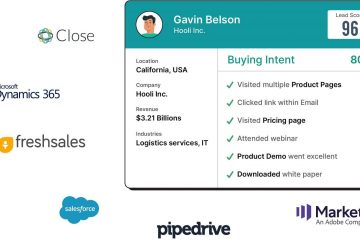Rule-Based Lead Scoring: Overview
As your traffic starts to increase, lead qualification becomes a significant part of your sales process. Your time and resources are limited and your sales team can only talk to a limited amount of people in a day. There are multiple ways to qualify leads and one of the most commonly used techniques is lead scoring. Lead scoring is a method where you assign scores to leads to qualify them. There are two popular lead scoring methods: predictive lead scoring and rule-based lead scoring. In this article, we will cover rule-based lead scoring (also called point-based lead scoring).
What is rule-based lead scoring?
Rule-based lead scoring is a method where you set up rules based on desired or undesired characteristics to score leads. Each rule rewards a set amount of points to a lead. When a lead performs the desired actions or has desired characteristics of the rule, the point is rewarded or deducted based on the setup. Rules are stacked up to create a workflow. A lead’s score keeps changing based on his behavior and profile. When a lead reaches the minimum point requirement set by the business, they are deemed qualified.
A lead can get a positive score or a negative score depending on the data attribute. For example, belonging to the target industry is given a positive score while an unfavorable behavior like unsubscribing to newsletters is given a negative score.
Using data to set up rule-based lead scoring
A rule-based lead scoring system can be created using data and behavioral attributes that are gathered by using a customer data and tracking platform.
Individual Data
Individual data is used to identify your leads. It can also be used to create scoring rules. Available data points usually include lead name, bio, job role, social media profiles, etc. The most commonly used qualifier is job role. Use job role to assign higher or lower scores based on a lead’s decision-making capabilities.
Demographic Data
Demographic data is used to determine if a lead belongs to a country your business markets to. Demographic information consists of geo-data which includes country, state, region, city, etc. You can create rules that assign scores based on a lead’s geographical location.
Technographic Data
Technographic data comprises of simple information like which device and browser they use to higher-level information that tells you about technologies that your leads use. If you are a SAAS company, technographic data can tell you about other SAAS products your leads use. You can use this data to create rules and score your leads.
Firmographic Data
A lead’s firmographic information helps you decide if their businesses belong to your ideal customer persona. Firmographic data includes company name, size, industry, and contact information. Company size is the most commonly used firmographic data attribute for lead qualification. If you are targeting enterprises, you can create rules to assign higher scores to leads from large businesses and negative scores to leads from very small businesses.
Behavioral Data
Behavioral data is gathered by tracking your leads. Use this information to determine lead intent. Commonly used behavioral data attributes are website visits, email opens, and session duration. You can create rules to qualify leads based on positive and negative behavior. For example, completing account setup and entering payment information is a positive behavior. Infrequent visits, low session duration, and newsletter opt-out can be considered negative behavior.
Rule-Based Lead Scoring with Salespanel
On Salespanel, we have three features to qualify leads: segmentation, automatic lead scoring, and rule-based lead scoring. After a lead is captured by Salespanel, it is enriched and tracked. The accumulated data can be used to create lead scoring workflows. A lead’s score is updated in real-time whenever a rule is triggered. You can also set up workflows to export leads who surpass the minimum requirement directly to your CRM. You can also set up workflows to notify your sales team of these qualified leads.
To conclude, rule-based lead scoring is one of the most commonly used lead qualification techniques and you simply can’t go wrong with it. The setup process is really simple and once you are done, things start to work on autopilot.
Sell more, understand your customers’ journey for free!
Sales and Marketing teams spend millions of dollars to bring visitors to your website. But do you track your customer’s journey? Do you know who buys and why?
Around 8% of your website traffic will sign up on your lead forms. What happens to the other 92% of your traffic? Can you identify your visiting accounts? Can you engage and retarget your qualified visitors even if they are not identified?





